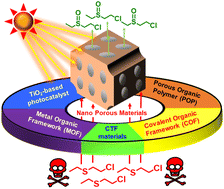A critical review on emerging photoactive porous materials for sulfide oxidation and sulfur mustard decontamination
Abstract
Chemical warfare agents (CWAs) have been classified as fatal weapons of mass destruction because of their toxicity and deadly consequences. Among other CWAs, sulfur mustards (HDs) were employed during the Iraq–Iran war (1984–1988), causing significant fatal effects for 100 000 military and civilian Iranians, and around 45000 people are still suffering from long-term health repercussions. Hence, the detection and detoxification of these acutely dangerous chemicals are critical for protecting ourselves and have thus sparked much scientific interest around the globe. In this regard, studies show that various photoresponsive porous organic materials like activated metal–organic-frameworks (MOFs), porous organic polymers (POPs), covalent organic frameworks (COFs), and TiO2-derived materials are highly effective for the photochemical detoxification of HDs. Given this context, we have traversed through the history of developing various photoresponsive porous materials and their efficacy in detoxifying CWAs, notably HDs. Moreover, we highlighted the numerous research methodologies reported to detect and modulate the excitonic effects in photoporous materials, which can tune the in situ-generated reactive oxygen species (ROS) responsible for HD detoxification. Lastly, we have listed the hurdles in creating photoactive porous materials and functionalizing them for large-scale HD detoxification. Although most of the described porous photocatalysts demonstrated good lab-scale performance, relatively few are accessible for large-scale industrial use. We have also addressed the future needs and potential for employing photoporous materials for efficient detoxification of HDs on an industrial scale to alleviate the issue of CWA/HD stockpiling and their potential use as a weapon of mass destruction.

- This article is part of the themed collection: 2023 Green Chemistry Reviews


 Please wait while we load your content...
Please wait while we load your content...